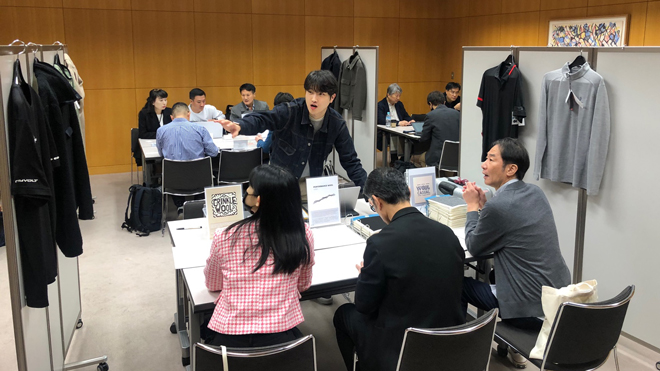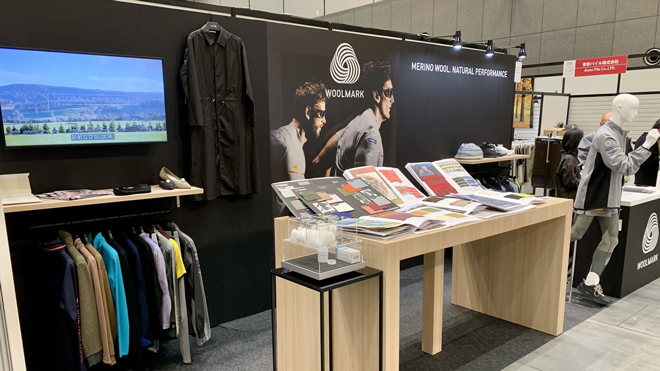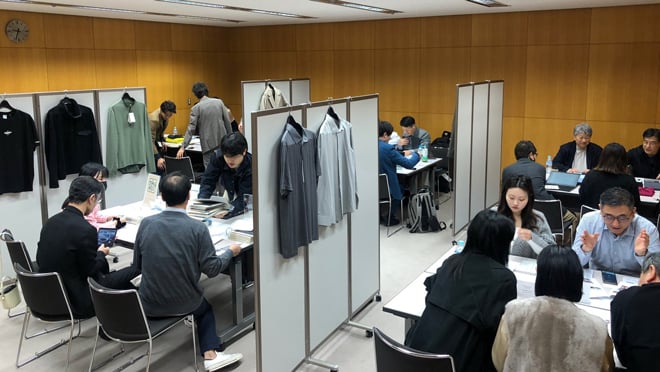Setting up business opportunities for wool

At the recent Japan Creation trade show, Woolmark set up business meetings between Japanese and South Korean textile trade suppliers to encourage new commercial opportunities for Australian wool.
In November, Woolmark exhibited at Japan Creation, the popular textile trade show in Tokyo hosted by Japan Fashion Week Organisation, to engage with and inspire leading textile manufacturers, brands and retailers in the region to include wool in their collections.
At the Woolmark booth, the company promoted the natural and performance benefits of Australian wool, and showcased a wide collection of the latest Merino wool products. The latest edition of Woolmark’s The Wool Lab sourcing guide to quality wool yarns and fabrics was also available for the thousands of trade show attendees to explore.

The Woolmark booth at Japan Creation.
Connecting the supply chain
In addition to having an exhibition booth at the trade show, Woolmark also arranged special meetings between Japanese and South Korean suppliers of wool yarn, fabric and apparel.
Both countries are important markets for Australian wool and have textile industries that produce high-quality wool products. Geographically, the two East Asian countries are located very close to each other, the shortest distance between Japan and the Korean Peninsula being only about 50 km. This close proximity makes transport and trade between the countries very easy and also minimises carbon footprints.

Making connections at the Japanese-Korean supplier meetings.
At the special Woolmark-facilitated meetings at Japan Creation, six large Korean suppliers keen on exploring overseas markets such as Japan were each introduced to 10 Japanese textile companies and trading houses.
AWI Regional Manager Japan & Korea, Samuel Cockedey, says the meetings helped connect some Woolmark’s key trade partners in the region and thereby build the demand for wool.
“We set up the meetings to initiate business conversations between some of our most important Korean and Japanese trade partners and create new opportunities for wool consumption,” Samuel said.
“The sessions were successful in bringing the suppliers’ latest commercially available wool offerings to the forefront of the trade buyers’ minds, at a time when they were considering fibre and fabric choices for their future collections and product ranges.
“Ultimately, the initiative was all about helping to connect and support the supply chain, and drive new demand for wool, which will benefit Australian woolgrowers.”
Successful meetings
Feedback from the Korean suppliers was that they found the sessions very useful for promoting their wool products to the Japanese companies and trading houses:
Daekwang Textiles: “We are focusing on expanding our sales beyond our domestic market, so the meetings were a good opportunity for us. It was great to be able to consult with 10 proven buyers from Japan.”
Aztech WB: “It was good to see the interest in our products from the Japanese trading houses and helpful to set up our direction for future business. It was good to understand more about the needs of the Japanese market.”
Yejin F&G: “It was a really good opportunity to expand our business, and a good experience to share market trends not only in Japan and Korea but also global trends.”
Grubig: “It was very useful to hear the opinions of the Japanese buyers to enable us to develop new products, especially as they are approved by Woolmark.”
The Japanese contingent was also very appreciative of Woolmark setting up the meetings:
San Marino: “Overall, it was great to participate in the sessions as there were lots of quality wool materials that I had never seen before.”
Toyoshima: “It was a great opportunity to meet the six Korean suppliers at the one event, which made it very productive timewise while at the trade show.”
Wool sourcing guides to Japan and South Korea
Woolmark has recently published two new sourcing guides for Japan and South Korea that highlight key information and contact details of the best spinners, weavers and knitters of Australian wool in these two countries.
These unique resources will help trade buyers, brands and designers from across the world to connect with the two countries’ suppliers, thereby helping to increase the demand for Australian wool.
Access the guides at www.woolmark.com/industry/source-wool.
Also available are sourcing guides for the Indian subcontinent and Vietnam.
This article appeared in the December 2024 edition of AWI’s Beyond the Bale magazine. Reproduction of the article is encouraged.












